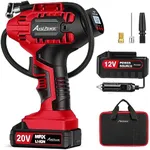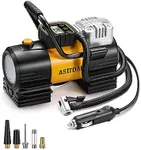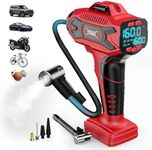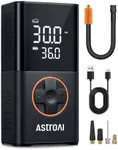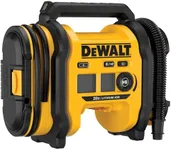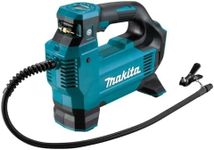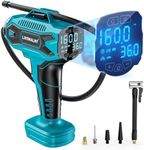Buying Guide for the Best Tire Inflators
Choosing the right tire inflator can make a big difference in how easily and quickly you can maintain your vehicle's tires. The best inflator for you depends on what type of vehicle you have, how often you need to inflate tires, and whether you want something portable or more powerful. Understanding the key features will help you pick a model that matches your needs and makes tire maintenance hassle-free.Power SourceThe power source refers to how the inflator is powered—commonly by your car’s 12V outlet, a wall plug, or a built-in rechargeable battery. This is important because it affects where and how you can use the inflator. 12V models are great for on-the-go use, plugging directly into your car, while wall-powered units are usually more powerful but less portable. Battery-powered inflators offer the most flexibility but may need regular charging. If you want an inflator for emergencies on the road, a 12V or battery-powered model is ideal. For home use or larger tires, a wall-powered inflator might be better.
Maximum Pressure (PSI)Maximum pressure, measured in PSI (pounds per square inch), tells you the highest pressure the inflator can deliver. This matters because different tires require different pressures. Most car tires need 30-40 PSI, while bike tires or truck tires may need more. Inflators with a maximum PSI of 100-150 are suitable for most car and bike tires, while higher PSI is needed for trucks or special equipment. Choose an inflator with a maximum PSI comfortably above your tire’s requirements to ensure it can handle the job.
Inflation Speed (CFM or L/min)Inflation speed is how quickly the inflator can pump air, often shown as CFM (cubic feet per minute) or L/min (liters per minute). This is important if you want to inflate tires quickly, especially if you have larger tires. Lower speeds (under 20 L/min) are fine for occasional use or small tires, while higher speeds (over 30 L/min) are better for frequent use or bigger tires. If you value speed and efficiency, look for a higher inflation rate.
Automatic ShutoffAutomatic shutoff is a feature that stops the inflator when the set pressure is reached. This is important for safety and convenience, as it prevents over-inflation and lets you multitask. Some inflators require you to watch the gauge and turn them off manually, while others let you set the desired PSI and handle the rest. If you want a worry-free experience, especially if you’re not used to inflating tires, look for an inflator with automatic shutoff.
Portability and SizePortability refers to how easy it is to carry and store the inflator. Smaller, lighter inflators are easier to keep in your car for emergencies, while larger models may be more powerful but less convenient to transport. If you need an inflator for roadside emergencies or travel, choose a compact and lightweight model. For home garages or regular use, a larger inflator may be acceptable.
Display and ControlsThe display and controls determine how easy it is to set and read the desired pressure. Digital displays are usually easier to read and more accurate, while analog gauges are simple but may be harder to interpret. Some inflators have simple buttons, while others offer more advanced settings. If you want a user-friendly experience, look for a clear digital display and straightforward controls.
Included AccessoriesIncluded accessories can make the inflator more versatile, such as extra nozzles for inflating sports balls, air mattresses, or bike tires. This is important if you plan to use the inflator for more than just car tires. If you want an all-in-one tool, check what accessories come with the inflator and make sure they match your needs.



